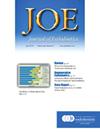常规凝固与快速凝固生物陶瓷中钙动力学的比较分析:对细胞毒性和磷灰石形成的影响。
IF 3.5
2区 医学
Q1 DENTISTRY, ORAL SURGERY & MEDICINE
引用次数: 0
摘要
简介本研究的目的是评估两种形式的内切酶根修复材料:常规组(ES)和快速组(ESF)的钙离子(Ca2+)释放、pH值变化、生物活性和细胞毒性:方法:对 ES(n=10)和 ESF(n=10)进行生物活性测试。对新鲜材料和在磷酸盐缓冲盐水(PBS)中浸泡 30 天的材料进行了元素分析。研究了表面晶体的形成。使用人肝癌细胞系(Huh-7)评估了不同浓度材料的细胞毒性:结果:两种材料都含有主要元素 Ca、P、Ta、Zr 和 Si。ES 和 ESF 都含有一定比例的镱和钕。在新鲜材料中,ES 的 Ca2+ 浓度比 ESF 高,表面分布均匀。然而,ESF 释放的 Ca2+ 明显更多:将 ES 和 ESF 浸入模拟体液中时,两种形态都会在牙本质材料界面上产生磷灰石晶体,释放出高 Ca2+,并显示出持久的高 pH 值和高生物活性潜力。两种形态的细胞毒性都很低。ESF 中较高的 Ca2+ 释放量表明其具有动态生物活性,这应符合临床要求。本文章由计算机程序翻译,如有差异,请以英文原文为准。
Comparative Analysis of Calcium Dynamics in Regular-Set versus Fast-Set Bioceramics: Impact on Cytotoxicity and Apatite Formation
Introduction
The objective of this study was to assess the calcium ions (Ca2+) release, pH shift, bioactivity, and cytotoxicity of both forms of EndoSequence Root Repair Material: regular set (ES) and fast set (ESF).
Methods
ES (n = 10) and ESF (n = 10) forms were tested for their bioactivity. Elemental analysis was done on the fresh material and material immersed in phosphate-buffered saline (PBS) for 30 days. The surface crystal formation was studied. Cytotoxicity was evaluated at different material concentrations using a human hepatocellular cancer cell line (Huh-7).
Results
Both materials contain Ca, P, Ta, Zr, and Si as major elements. Both ES and ESF have a limited percentage of ytterbium and neodymium. In the fresh material, compared with the ESF, the ES had a higher Ca2+ concentration with a homogeneous surface distribution. However, the ESF released significantly more Ca2+ (P < .05) and had a higher pH over the 7-day course. When the material was immersed in PBS, the ESF exhibited a significantly higher Ca/P ratio of 2.95, while ES had 2.16 Ca/P ratio (P < .05). The ESF had a greater capacity to precipitate and grow hydroxyapatite (HA) than ES, resulting in more mature crystals forming on the surface. Both SE and ESF demonstrated low cytotoxicity against Huh-7 cells.
Conclusions
When ES and ESF were submerged in simulated bodily fluid, both forms produced apatite crystals at the dentin material interface, releasing high Ca2+ and displaying a prolonged high pH with high bioactivity potential. Both forms had comparable low cytotoxicity. A higher Ca2+ release in ESF indicates dynamic bioactivity, which should be aligned with the clinical requirements.
求助全文
通过发布文献求助,成功后即可免费获取论文全文。
去求助
来源期刊

Journal of endodontics
医学-牙科与口腔外科
CiteScore
8.80
自引率
9.50%
发文量
224
审稿时长
42 days
期刊介绍:
The Journal of Endodontics, the official journal of the American Association of Endodontists, publishes scientific articles, case reports and comparison studies evaluating materials and methods of pulp conservation and endodontic treatment. Endodontists and general dentists can learn about new concepts in root canal treatment and the latest advances in techniques and instrumentation in the one journal that helps them keep pace with rapid changes in this field.
 求助内容:
求助内容: 应助结果提醒方式:
应助结果提醒方式:


